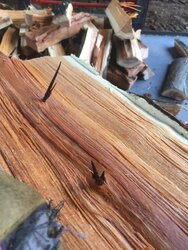walhondingnashua
Minister of Fire
Evolution actually follows its own rules perfectly. Species do not evolve a trait for no reason unless it is a simple one genetically and has no negative impact (like blue eye color). This generally occurs through genetic drift from a neutral mutation. However, a trait will not go away unless there is enough selective pressure to to do so before reproduction. The thorns do not cause any negative selective pressures, therefor they do not go away. Goosebumps do nothing for you anymore, but the muscles that raise your hairs and cause them (erector polo) never had enough pressure to go away, so you still get goosebumps when you’re cold or excited.
So, until enough people cut down all honey locust with thorns as soon as they ID them, and then do it for many generations, we’re “stuck” with them lol.
So, until enough people cut down all honey locust with thorns as soon as they ID them, and then do it for many generations, we’re “stuck” with them lol.


